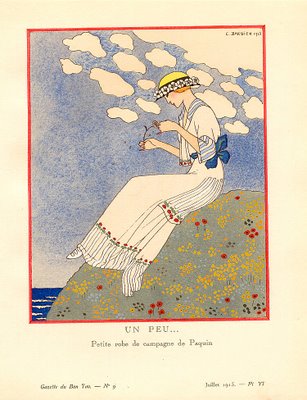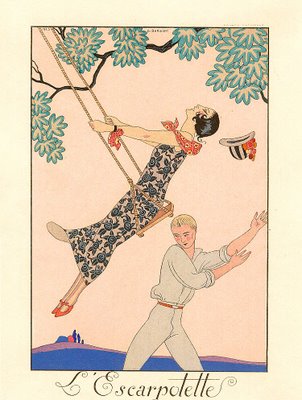 Getting to see so many museums and galleries in the past few days and increasing exposure to the early 20th Century has put me in an Art Deco mood. It is an era that I simply adore, from painting to sculpture to fashion to design -- every element of that era has a simultaneously glamorous but relaxing geometry.
Getting to see so many museums and galleries in the past few days and increasing exposure to the early 20th Century has put me in an Art Deco mood. It is an era that I simply adore, from painting to sculpture to fashion to design -- every element of that era has a simultaneously glamorous but relaxing geometry.Today, let's look at French illustrator George Barbier (1882-1932). He debuted in 1911 and was swept to fame in illustration, fashion, and set design, as well as contributing to jewelry, wallpaper, and glasswork. Barbier's works are reminiscent of the languishing, indealized portraits of Greco-Roman life by Alma-Tadema and Godward.
This is La Villa D'Este (1923). I love his selection of colors, strikingly different but building unity in whole composition. Compare it with this picture to see what I mean by Neoclassical idealism. Barbier and Alma-Tadema were appealing to the same elegance.
 Ah, idyll joys of being idle! This is Un Peu (1913). As I've noted before, engaging with art is like taking a mini-vacation away from the troubles of the world. Godward thought along the same lines.
Ah, idyll joys of being idle! This is Un Peu (1913). As I've noted before, engaging with art is like taking a mini-vacation away from the troubles of the world. Godward thought along the same lines. Barbier captured the self-deluded ecstasy of the Roaring Twenties, much like the playful oblivion of the French Rococo period. This is L'Escarpotette (1924).
Barbier captured the self-deluded ecstasy of the Roaring Twenties, much like the playful oblivion of the French Rococo period. This is L'Escarpotette (1924).

2 comments:
These are reminiscent of Japanese art to me, but I'm not sure I can say why. Is it because the eye is drawn to view them linerally rathar than panning the scene (as in a Gauguin).
I suppose that is less true for _En Pue_ than for the other two.
It's probably reminiscent of Japanese art because of the dominance of line, as well as the solidity of colors. There are few shades in Barbier's work.
Post a Comment